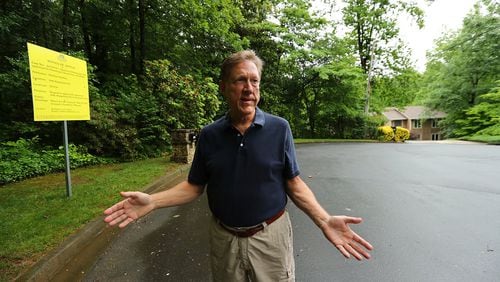In the 38 years since Michael Hartley bought his house on a wooded Roswell cul-de-sac, he’s gotten used to the quiet.
It helps that his neighbor built only one house on the three lots he owns next door.
But that neighbor is ready to move. And he plans to sell his lots to a developer who'd like to extend the cul-de-sac and build another 19 homes in Hartley's quiet corner of the city.
“It’s a fairly old, established neighborhood,” Hartley said of the 1970s development near the intersection of Wileo and Coleman roads. “When you live on a cul-de-sac, who would ever expect it would be anything other than a cul-de-sac?”
More and more, though, developers are looking for new places to squeeze in homes — even in metro Atlanta neighborhoods that have been there for decades. As the price of land goes up, traffic gets worse and more people want to be closer to jobs in Atlanta and the northern Perimeter, any extra space is enticing to builders, said John Hunt, principal of real estate research firms ViaSearch and MarketNsight.
The Atlanta Regional Commission estimates the metro population will increase by 2.5 million people by 2040 — roughly the equivalent of the entire population of metropolitan Charlotte, N.C., moving to the region.
“People’s incomes are flat, and land costs have exploded up,” Hunt said. “People have to have somewhere to live.”
So they’re moving into once-sleepy areas, where development has boomed. Roswell now boasts nearly 95,000 residents, while Sandy Springs has more than 105,000. Brookhaven has more than 50,000 residents.
Some parts of metro Atlanta are better equipped to handle more houses — and more people — than others, said Sam Shenbaga, the division manager of community development for the Atlanta Regional Commission. Neighborhoods that are near town centers, public transit or commercial nodes should expect to become more densely developed as time goes on. But, he said, it may not make sense to add more homes to some traditional subdivisions, or historic neighborhoods.
“We’re going to grow, and we need to make sure we grow in a sensible manner,” Shenbaga said. With more home construction adding density to places where people already live, “we’re going to get sidewalks, bike paths… There’s a place for preservation and a place for redevelopment.”
Roswell’s comprehensive plan seeks to protect existing neighborhoods while allowing for improvements in corridors that need it, city spokeswoman Julie Brechbill said.
Hartley doesn’t think his own neighborhood is the right place for intense redevelopment. He and others are fighting his neighbor’s plan, which has become a cause célèbre in the area. Over the course of a week, an online fundraiser has earned a quarter of its $5,000 goal to pay for legal fees.
Hartley has appealed the planning commission's approval of the new development's preliminary layout, and he hopes Roswell city council members will see fit to grant him a reprieve from the growth. Others haven't been so lucky.
Diane Boyles knew when she bought her house on Hibernia Avenue in Decatur that the Decatur United Church of Christ was being torn down and 20 townhomes were being built in its place. After all, that’s why the previous owner was selling.
Still, she wasn’t prepared for the way it would change her experience in her home.
First, there was more than a year of construction, with the noise and the flat tires that came with it.
When the church was there, kids would play on the lawn and people would let their dogs run free, Boyles said. They would stop to chat with neighbors. Now, she said, there’s not as much of a community feel. Instead, it’s noisier. There are more cars. And there is nowhere for the kids to play.
In Sandy Springs, when Pulte took down about half a dozen single-family homes, Jerry Monash and his neighbors tried to get the developer to build new houses — even if there were more of them.
Instead, the Terraces at Glenridge, which backs up to Monash’s house, has roughly five dozen condos and townhouses. It’s added traffic to the area and, he fears, could reduce the potential upside for property values in the neighborhood.
Monash said the homes that were there needed to come down, but he wanted something a little less intense.
“It’s not what I anticipated would be here when I bought here,” said Monash, who moved in in 1999. “It’s destroying what a lot of people have come to like about this neighborhood.”
Cognizant of the ways new construction can change a neighborhood’s character, some metro areas are trying to control when and how it happens.
Sandy Springs is working to protect some communities, Mayor Rusty Paul said. Once a citywide review of neighborhoods is complete, Paul expects about 60 percent of the subdivisions in Sandy Springs to be protected from projects that would greatly increase the number of homes.
Paul said in drafting the new rules, he wanted to help minimize disruption to communities, as well as maintain a range of housing options. Without stricter protections, he said, “council has to play Solomon to figure out what’s the wise thing to do.”
People who move into a neighborhood and invest in that neighborhood have the right to expect there won’t be wholesale change, Paul said. But cities and neighborhoods evolve, and nothing is guaranteed to stay the same forever. Not even on a cul-de-sac.
“It’s a perpetual problem in communities that are very popular, that are close-in, that are mature,” he said. “We’ve been dealing with it for a while.”
In Gwinnett County, however, planning and development director Kathy Holland has been working on creating rules that would apply to certain areas where the county wants redevelopment to happen.
The project, called an overlay district, is still in the works. But once complete, it would set specific rules for distinct areas where the county wants to encourage denser redevelopment. The overlay district would give builders incentives to make new construction more walkable, create community gathering spaces or add neighborhood retail stores so people won’t have to get in their cars as much.
The plan is intended to work in existing neighborhoods, and to direct developers to specific areas where growth is most appropriate. County officials hope the final result fits in with what’s already there, even if it increases density.
When there is no plan in place, increased density can change an area from the inside, said Ron Sifen, a community advocate in Vinings. That's what happened in Brookhaven, he said, where homes were torn down to build apartments near Dresden Drive and three single-family houses were often razed to build six.
“It feels different to a homeowner who bought into a particular community,” he said. “In many cases, you’re changing to a character that’s less desirable. For people who have invested in our homes, our communities, who already lived there, that’s a real issue.”
In Cobb County, Sifen said, residents have had some success negotiating with developers to bring the scale of proposed new construction down to a level they’re more comfortable living next to. There are still new residents, often in neighborhoods that are long-established. But there are fewer than there would have been if developers had been able to build what they originally proposed.
Sometimes, he said, that’s the best residents can do.
Hartley, in Roswell, has to wait until at least the end of the month to see which way his cul-de-sac goes. He, too, thinks the issue of established neighborhoods suddenly dealing with new developments will become increasingly prevalent. So does Kathy Zickert, the attorney representing Hartley’s Ridgefield Drive neighbor in his quest to sell the land and build the additional homes.
As more people move to Atlanta, she said, the only way to house them is to build more apartments and condominiums, or more infill homes.
“This is not a new kind of phenomenon, by any means,” Zickert said. “We’re not making any more dirt.”
MYAJC.COM: REAL JOURNALISM. REAL LOCAL IMPACT.
The AJC's Arielle Kass keeps you updated on the latest happenings in Fulton County government and politics. You'll find more on myAJC.com, including these stories:
Never miss a minute of what's happening in Fulton politics. Subscribe to myAJC.com.
In other North Fulton news:








